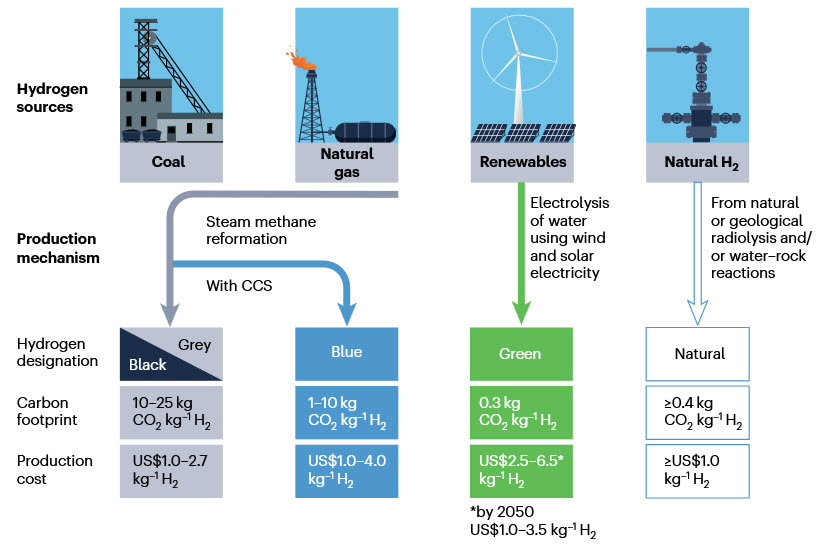Nature Reviews Earth & Environment
Scientists from the University of Oxford, Durham University, and the University of Toronto have identified in a paper, Natural hydrogen resource accumulation in the continental crust, the key geological factors necessary to locate natural clean hydrogen beneath the Earth’s surface.
The Earth has generated this natural hydrogen over millions of years, and it can accumulate underground in specific rock formations.
There are two mechanisms whereby this natural hydrogen is generated within the crust: water–rock reactions where Fe2+, dominantly in ultramafic rocks, is oxidized to Fe3+, and by radiolysis of water via radioactive elements uranium, thorium, and potassium within the upper-crustal rocks. The two-generation reactions operate on different timescales, ranging from thousands to millions of years for the water–rock reaction, and tens to hundreds of millions for the radiolysis reactions.
The study indicates that conditions suitable for trapping hydrogen exist in many regions worldwide, presenting a global opportunity.
Hydrogen is a $135 billion industry, primarily used to produce fertilizers and other essential chemicals supporting modern life. Moreover, it is a fundamental component for future clean energy systems, with the market projected to grow to as much as $1 trillion by 2050.
The researchers claim their findings could assist industries in discovering and utilizing natural hydrogen reserves, providing a cleaner alternative to current hydrogen production methods that depend on fossil fuels, which add CO2 to the atmosphere, and that renewable-powered electrolysis is not yet cost-competitive. Over the past billion years, the crust has generated enough hydrogen to meet human energy needs for roughly 170,000 years, and much of that gas remains untouched and emission-free.
The potential for natural geological hydrogen has motivated the authors to form Snowfox Discovery Ltd., an exploration company with a mission to find societally significant natural hydrogen accumulations.
The most societally significant natural hydrogen exists in the Earth’s oceans, which contain approximately 97% of the planet’s water, about 1.335 billion cubic kilometers, about 1.35 billion trillion liters.
According to the National Institutes of Health, the following table shows that a liter of water contains 111.9 grams of hydrogen, which is theoretically about 252 billion years’ worth when produced at a rate of 20 terawatts/year (TW), which is the current rate of primary energy consumption.
| billion | trillion | Total | Grams | Total Grams | Killogram | kwh/kg | Total Kwh | 20 TWs | years | |
| 1.35 | 1000000000 | 1E+12 | 1.35E+21 | 112 | 1.512E+23 | 1.512E+20 | 33.33 | 5.0395E+21 | 20,000,000,000 | 251,974,800,000 |
In reality, this hydrogen would be available in perpetuity because it would be combined in either a combustion engine or a fuel cell to produce more water and energy. Furthermore, the energy available for the electrolysis that would produce the hydrogen is also available in perpetuity for as long as the sun continues to shine and icecaps melt every winter, with ocean thermal energy conversion (OTEC) at an equivalent rate of 25 TW.
The paper An assessment of ocean thermal energy conversion resources and climate change mitigation potential, by a team of researchers from the University of Victoria, estimated the sustainable maximum power production rate of OTEC at 5 to 10 TW. This was, however, for conventional OTEC using a cold water pipe design that is about 3% efficient.
With a deep water condenser design, which is 7.6% efficient, the potential is 25 TW in perpetuity.
According to the Oxford paper, the cost of green hydrogen produced by wind and solar energy will be between US$1 and US$3.5 by 2050. As shown here, with backup, wind and solar are currently between 10 and 40 times more expensive than the deep water condenser design for OTEC, so hydrogen produced with this power would be considerably cheaper than hydrogen produced with the so-called “Natural” method, notwithstanding the fact that the “Natural” method does nothing for the greatest risks from climate change, which are sea level rise and storm surge.










